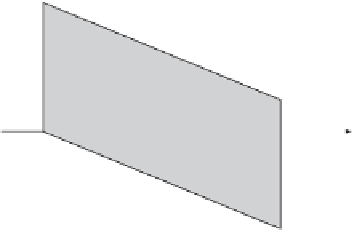Graphics Programs Reference
In-Depth Information
P
*
θ
z
Q
P
Figure 2.13: Oblique Projections.
origin to
P
is the segment of size
s
from the origin to (
a, b,
0). The value
s
is therefore
the shrink factor of the oblique projection. The three quantities
a
,
b
,and
s
are related
by
a
=
s
cos
φ
and
b
=
s
sin
φ
,where
φ
is measured on the projection plane. The shrink
factor
s
is also related to the projection angle
θ
by tan
θ
=1
/s
or
s
=cot
θ
.
The diagram can be drawn quite quickly because the designer used a style of drawing
called oblique projection. So long as basic rules are followed, oblique projection is
quite easy to master and it may be a suitable style for you to use in a design project.
The basic rules are outlined below.
http://www.technologystudent.com/designpro/oblique1.htm
We now consider the projecting ray from
Q
to (
A, B,
0). Since
Q
is at a distance
z
from the origin, the distance on the projection plane between the origin and point
(
A, B,
0) is
sz
. From this we obtain the relations
A
=
sz
cos
φ
and
B
=
sz
sin
φ
.The
next step is to consider the projection of a general point (
x, y, z
). All the projecting
rays are parallel, so a little thinking shows that moving a point from (0
,
0
,z
)to(
x,
0
,z
)
moves its projection from (
A, B,
0) to (
x
+
A, B,
0). Similarly, moving a point from
(0
,
0
,z
)to(0
,y,z
) moves its projection from (
A, B,
0) to (
A, y
+
B,
0). A general point
located at (
x, y, z
) is therefore projected to a point at (
x
+
A, y
+
B,
0). Thus, the rule
of oblique projections is
(
x, y, z
)
−→
(
x
+
sz
cos
φ, y
+
sz
sin
φ,
0)
,
(2.8)
whichcanbewrittenintermsofatransformationmatrix
⎛
⎞
1
0
0
⎝
⎠
.
P
∗
=
PT
=(
x, y, z
)
0
1
0
(2.9)
s
cos
φs
sin
φ
0
With the help of this matrix we examine the following special cases.
1. A cavalier projection. It is defined as the case where the projection angle is 45
◦
,
which implies
s
= cot(45
◦
) = 1. Thus, all edges and segments have shrink factors of 1.
2. A projection angle of 90
◦
.Avalue
θ
=90
◦
implies a shrink factor
s
= cot(90
◦
)=
0. Matrix
T
of Equation (2.9) reduces to matrix
T
z
of Equation (2.1), showing how
the oblique projection reduces in this case to an orthographic projection.










Search WWH ::

Custom Search